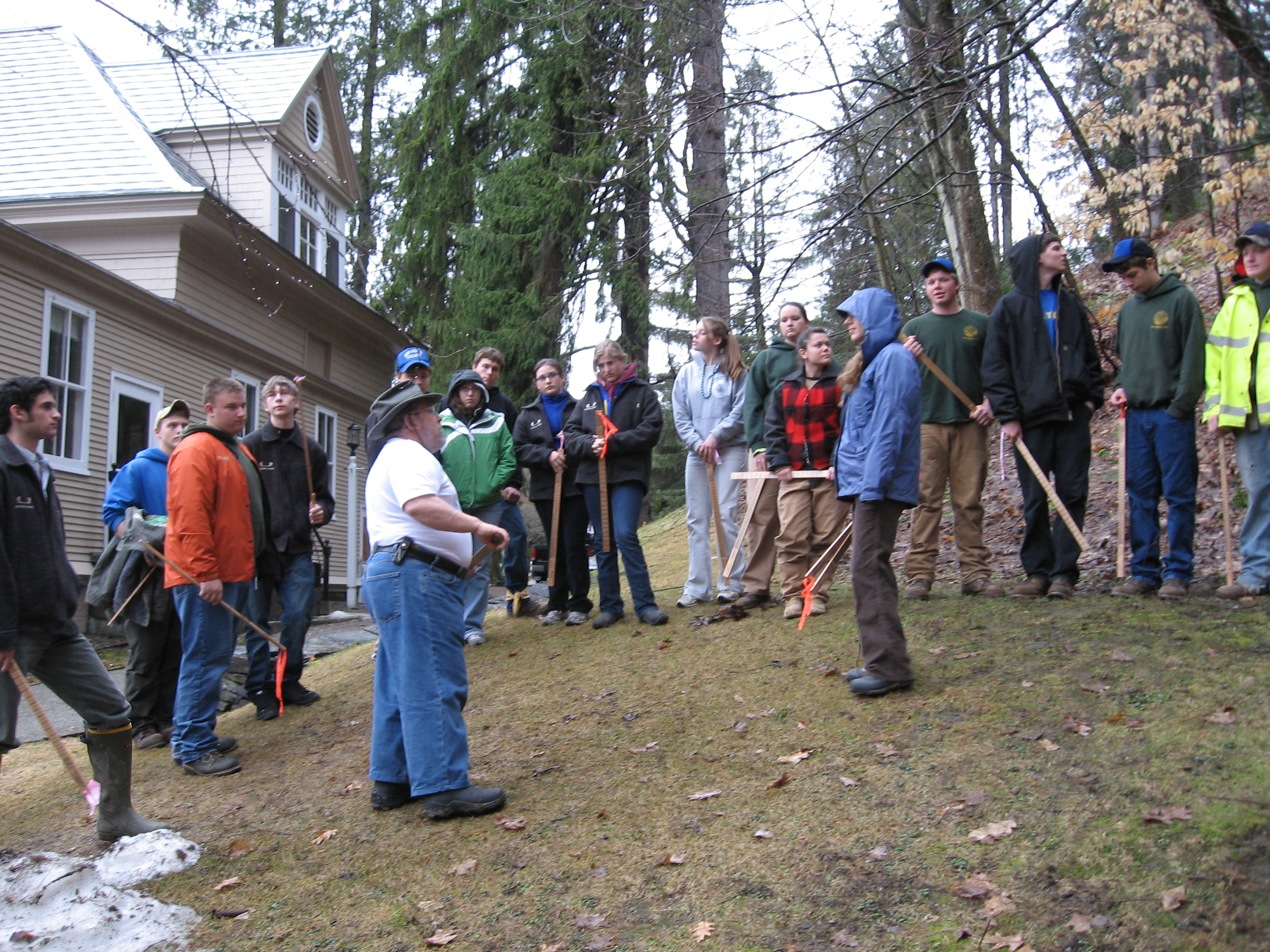Staff report – Published: April 26, 2009
In a five-acre parcel behind Stafford Technical Center in Rutland, students are studying water quality, analyzing soils, and observing the local inhabitants – both plants and animals.
“If you take just a square foot of earth, you can find literally hundreds of species,” explains Mark Skakel, who teaches in Stafford’s natural resources, forestry and horticulture program.
The students, from seven area high schools, are getting ready to participate in the Vermont Envirothon, an annual competition that takes place this year on May 19 at the Kehoe Conversation Camp in Hydeville. The Envirothon focuses on environmental issues related to forestry, wildlife, soils and water resources. To prepare for the challenge the students perform a series of in-class projects and hands-on field activities. In the process they learn about the natural world and how science-based investigations can help resolve environmental issues.
The Envirothon, North America’s largest high school environmental education competition, gives students the chance to get “up close and personal” with their local, natural resources and make global connections. This year’s topic is biodiversity, defined as “the range of organisms present in a particular ecological community or system.” During the competition the students will be required to identify varying characteristics of different aspects of the natural world – forestry, aquatics, wildlife and soils.
“The Envirothon really helps the students open their eyes to the natural world,” explains Skakel. “They also get some real-life experience by working with experts in the field.”
As part of the training for the Envirothon, Skakel arranges for instruction sessions with scientists and other professionals from the relevant disciplines. Biologists from the Vermont Fish & Wildlife Department have taught the students how to recognize tracks and other animal signs; researchers from the Agency of Natural Resources helped the students study streams to determine how healthy they are. And Skakel brought in experts from the U.S. Natural Resources Conservation Service to discuss various types of soils and their management.
“It’s always better for the students to get the information from another person besides me,” says Skakel. “And this way they are gaining experiences and making connections that will make it easier for them to enter the job market some day.”
Skakel’s students are gaining a deeper appreciation of the importance of Vermont’s forests – a valuable natural resource that provides a variety of forest-related products, clean air and water, soil stability and habitats for wildlife. They are studying how aquatic ecosystems can be affected by human activities such as agriculture, industry, introduction of invasive species, runoff from parking lots and much more. Part of their research is to explore how changes to the ecosystem – whether natural or man-made – impact wildlife populations. The students are also learning to identify soils that are best suited for forestry agriculture, housing and wildlife.
The five-acre parcel of land behind the school is diverse area that the group has been studying for several months. A healthy stream (the headwaters of Moon Brook) runs through the area, but downstream where it flows through more densely populated areas of Rutland, the stream is “somewhat depleted,” according to Skakel. Determining where and why the quality of the stream deteriorates is one question the students are trying to answer.
They are also cataloguing the plant and animal species present in the five-acre habitat block. Many types of trees can be found in the area, ranging from hard hack to witch hazel. Several invasive species are also present – honeysuckle, firebush, and Norway maple. The soil types vary from mucky (near the stream) to quite sandy at slightly higher elevations – ideal for white pines and also favored by foxes who typically dig their dens in sandy soils.
The students have noted how the wildlife population is affected by the nearby Gleason Road waste transfer station, used by rabbits and other rodents as a source of food and shelter. The foxes in turn profit from the burgeoning population of smaller animals, as do owls and other birds of prey.
By observing tracks in the snow this winter, the students found evidence of many predator-prey encounters. “Rabbits came for the twigs we put out,” describes Skakel, “and the foxes ate the rabbits. We saw the tracks and the blood. We also saw vole tracks that stopped by the outline of owl wings.”
Next week the students will begin planting 1,000 trees along Otter Creek as part of a project for the Rutland Natural Resources Conservation District. The goal is to prevent erosion and water runoff along the creek. The trees to be planted – including hazelnut, maple, white pine and hard hack – were selected based on analyses of the soil along the creek, which is primarily sandy loam.
“In this project students must learn about the relationships between soils, water quality and plant life in order to select the tree species best suited to the conditions along the creek,” explains Skakel.
“They are also working with professionals from the conservation district,” he adds. “This means that in the process of preparing for the Envirothon they are acquiring the skills and connections that will help them as they enter the job market, which is an important aspect of our program at Stafford.”
The Vermont Envirothon is sponsored by the Vermont Association of Conservation Districts. Program partners include the state’s 14 conservations districts; the Vermont Fish & Wildlife Department, the Vermont Department of Forests, Parks, and Recreation; Vermont Department of Environmental Conservation; U.S. Forest Service; U.S. Natural Resources Conservation Service; George D. Aiken Resource Conservation and Development Council; the Northern Vermont Resource Conservation and Development Council. Additional sponsors this year include Elemental Energy, Inc.; Green Mountain Club, High Mowing Organic Seeds, Orvis Sporting Traditions, Society of Soil Scientists of Northern New England, Two Rivers-Ottauquechee Planning Commission, Northwest Regional Planning Commission, and the Rutland Regional Planning Commission.
ON THE NET
Forestry Program, Stafford Technical Center
staffordonline.org/day-programs/53/
Vermont Envirothon
vacd.org/envirothon/index.html

